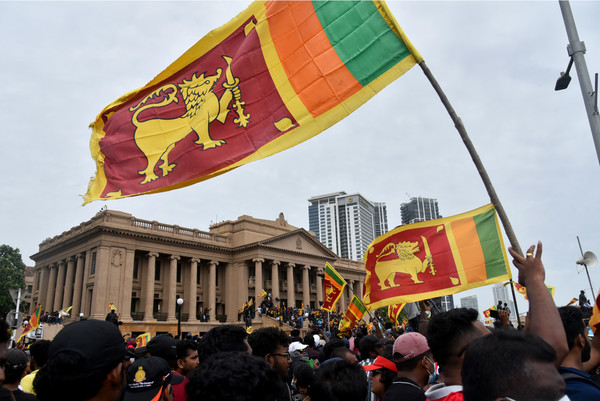Recently, Sri Lanka fell into national bankruptcy, and the vast majority of Sri Lankans greatly suffered in maintaining their livelihoods. The mass protests by an angry public were violent, setting fire to the president and prime minister's residences. It forced the president to evacuate the country, resulting in the election of a new president. Now, Sri Lankans are preparing to paint a new future with the newly established government. Let's take a look at the causes, developments, and future prospects of these protests with CAH.

1. Mass Protest and the President Flees
Mass protests took to the streets in March as fuel and food prices soared. Sri Lankans blamed the government for the shortage of foreign exchange and initiated their protest. In the early days, protests took place in a relatively peaceful manner, such as street marches, demanding the resignation of Gotabaya Rajapaksa and Mahinda Rajapaksa, the president’s brother and prime minister. As a result, Mahinda Rajapaksa resigned in May. But the protests grew in size and influence, becoming the most violent in July as the president did not comply with the public’s demands and the economy did not at all improve. Groups of Sri Lankans stormed into the president's residence, and the president appointed Ranil Wickremesinghe[1] as acting president as he rushed out from Colombo to Maldives via military aircraft. He subsequently submitted his resignation in Singapore and moved to Thailand.
2. The Impact and the Cause of Economic Crisis
a. The Current Circumstance
The most critical matter is the difficulty of maintaining a basic living due to electricity cutoffs, lack of fuel, food, and medicine. According to the Sri Lanka’s inflation index released by Trading Economics,[2] inflation in the Sri Lankan economy began in January this year and rose steadily through August to an unprecedented 64.3 percent[3]. What is worse, is the inability to import the fuel needed to operate essential infrastructure such as subways and buses. The skyrocketing price of diesel and gasoline due to their shortage went without saying; in late June, Sri Lanka’s government only sold fuels to vehicles with the purposes of medical or food-transportation.
b. The Cause of Economic Meltdown
A sharp drop in imports due to the lack of foreign exchange is pegged as the biggest cause of the economic crisis. On 18 May this year, the government declared default after failing to pay off foreign debts for the first time in Sri Lanka's history. Failure to redeem the debt can undermine the country’s reputations to investors, making it more difficult to borrow money in the future. Since 2009, when the Sri Lankan Civil War ended, the Sri Lankan government has implemented a policy to increase imports while maintaining exports to revive its economy. Consequently, Sri Lanka’s imports today are $3bn more than that of their exports.[4] Greater imports with sustained export naturally led to the cutback of foreign exchange reserves, leaving only $1,850Mn[5] as of June this year. When the Sri Lankan government recognized its shortage as a serious problem in early 2021, the government banned the import of chemical fertilizers to encourage the use of locally produced organic fertilizers. Contrary to their expectations, the policy caused a grievous crop failure and exacerbated the shortage of foreign exchange reserve as it forced the government to import even more food. As such, the government’s inept policies called for the public outcry.

3. The Awaiting Future of Sri Lanka
a. Possibility of the Resumption of the Protest: The Return of the Former President
Gotabaya Rajapaksa (former president), who left Sri Lanka in a hurry, returned to Colombo on 3 September without any advance notice. Some have expressed concerns that his return could once again resume the protests. Meanwhile, some protesters reassured the main purpose of the protests was to disqualify the incompetent president as Sri Lanka's leader and showed little opposition towards Mr. Rajapaksa’s return. On the one hand, some groups of protesters claim that he should be responsible for the faults he made as president, but experts say that the protest is unlikely to resume because the protests met their purpose.
b. Sri Lanka’s Prospect: Wickremesinghe’s Future Plans
Wickremesinghe took office as acting president and was elected president on 21 July this year through parliamentary elections. Wickremesinghe foretold several policies to break down economic hardship. The Sri Lankan government announced that it would print more money to pay workers' salaries and declared that state-owned airline Sri Lankan Airlines could be privatized. However, with a large amount of national debt still remaining, many experts agree that Sri Lanka will need time to repair its economy.
Sri Lanka this year went through the worst economic dark age in its history. Sky-rocketing inflation has made it difficult for people to maintain their basic livelihoods, with electricity cutoffs and fuel shortages. In response, Sri Lankans took to the streets to express their strong opinions about their incapable government. Although the process was not always peaceful and democratic, Sri Lankans succeeded in changing the government as most Sri Lankans wished. Though there are still foreign exchange debts to be repaid, it is too early to make any judgement on Sri Lanka’s future at this point, for they have only recently established a new government. Therefore, CAH hopes Sri Lanka to receive constant attention and the support they need for their successful rehabilitation.
[1] The prime minister after Mahinda Rajapaksa resigned.
[2] “Sri Lanka Inflation Rate”, August 2022 Data. Provided by Trading Economics and Central Bank of Sri Lanka
[3] Food, which contributed the most to the inflation, increased by 93.7 percent. Service, such as transportation, restaurants, and hotels, increased by 50.2 percent.
[4] Reported by BBC News in July 2022.
[5] “Sri Lanka Foreign Exchange Reserves”, August 2022 Data. Provided by Trading Economics.

